Optimizing Land Use to Mitigate Ecosystem Service Trade-Offs Using Multi-Scenario Simulation in the Luo River Basin
Abstract
1. Introduction
2. Materials and Methods
2.1. Study Area
2.2. Data Source
2.3. Research Methods
2.3.1. Ecosystem Services Assessment
- (1)
- Water yield
- (2)
- Carbon storage
- (3)
- Habitat quality
- (4)
- Soil conservation
2.3.2. Identification of Trade-Off Areas Based on Production Possibility Frontier
2.3.3. Scenario Setting
3. Results
3.1. Spatial and Temporal Changes in Ecosystem Services
3.2. Trade-Off Region Identification and Nonlinear Characterization
3.3. Multi-Scenario Modelling Projections
3.4. Changes in ES Trade-Offs under Different Scenarios
4. Discussion
4.1. ESs Quantification and Nonlinear Characterization of Trade-Offs/Synergies
4.2. Multi-Scenario Projections of Ecosystem Services
4.3. Implications for the Sustainability of Ecosystem Services
4.4. Limitations
5. Conclusions
Supplementary Materials
Author Contributions
Funding
Data Availability Statement
Acknowledgments
Conflicts of Interest
References
- Costanza, R.; de Groot, R.; Farber, S.; Grasso, M.; Hannon, B.; Limburg, K.; Naeem, S.; VO’Neill, R.; Paruelo, J. The value of the world’s ecosystem services and natural capital. Ecol. Econ. 1998, 25, 3–15. [Google Scholar] [CrossRef]
- Li, S.; Zhang, C.; Liu, J.; Zhu, W.; Ma, C.; Wang, J. The tradeoffs and synergies of ecosystem services: Research progress, development trend, and themes of geography. Geogr. Res. 2013, 32, 1379–1390. [Google Scholar]
- Meng, H.; Zhou, Q.; Li, M.; Zhou, L.; Liu, B.; Peng, C. Study of the spatio-temporal changes in ecosystem services and trade-offs/synergies relationship in the Three Gorges Reservoir area. Ecol. Rural. Environ. 2021, 37, 566–575. [Google Scholar] [CrossRef]
- Hu, Q.; Chen, S. Tradeoffs-synergies Analysis among Ecosystem Services in Xiamen-Zhangzhou-Quanzhou Area. Areal Res. Dev. 2021, 40, 145–150. [Google Scholar] [CrossRef]
- Liu, Y.; Geng, W.; Shao, J.; Zhou, Z.; Zhang, P. Land use change and ecosystem service value response from the perspective of “ecological-prodection-living spaces”: A case study of lower Yellow River. Areal Res. Dev. 2021, 40, 129–135. [Google Scholar]
- Feng, Y.; Cao, Y.; Li, S.; Wang, S.; Liu, S. Trade-offs and synergies of ecosystem services: Development history and research characteristics. J. Agric. Resour. Environ. 2022, 39, 11–25. [Google Scholar] [CrossRef]
- Daryanto, S.; Fu, B.; Zhao, W. Evaluating the use of fire to control shrub encroachment in global drylands: A synthesis based on ecosystem service perspective. Sci. Total Environ. 2019, 648, 285–292. [Google Scholar] [CrossRef] [PubMed]
- Geneletti, D.; Scolozzi, R.; Adem Esmail, B. Assessing ecosystem services and biodiversity tradeoffs across agricultural landscapes in a mountain area. Int. J. Biodivers. Sci. Ecosyst. Serv. Manag. 2018, 14, 189–209. [Google Scholar] [CrossRef]
- Jia, X.; Fu, B.; Feng, X.; Hou, G.; Liu, Y. The tradeoff and synergy between ecosystem services in the Grain-for-Green areas in Northern Shaanxi, China. Ecol. Indic. 2014, 43, 103–113. [Google Scholar] [CrossRef]
- Schirpke, U.; Candiago, S.; Vigl, L.E.; Jäger, H.; Labadini, A.; Marsoner, T.; Meisch, C.; Tasser, E.; Tappeiner, U. Integrating supply, flow and demand to enhance the understanding of interactions among multiple ecosystem services. Sci. Total Environ. 2019, 651, 928–941. [Google Scholar] [CrossRef] [PubMed]
- Bai, Y.; Zhuang, C.; Ouyang, Z.; Zheng, H.; Jiang, B. Spatial characteristics between biodiversity and ecosystem services in a human-dominated basin. Ecol. Complex. 2011, 8, 177–183. [Google Scholar] [CrossRef]
- Fu, B.; Zhang, L. Land-use change and ecosystem services: Concepts, methods and progress. Prog. Geogr. 2014, 33, 441–446. [Google Scholar] [CrossRef]
- Qin, K.; Li, J.; Yang, X. Trade-off and synergy among ecosystem services in the Guanzhong-Tianshui Economic Area of China. Int. J. Environ. Res. Public Health 2015, 12, 14094–14113. [Google Scholar] [CrossRef] [PubMed]
- Qiao, X.; Gu, Y.; Zou, C.; Xu, D.; Wang, L.; Ye, X.; Yang, Y.; Huang, X. Temporal variation and spatial scale dependency of the trade-offs and synergies among multiple ecosystem services in the Taihu Lake Basin of China. Sci. Total Environ. 2019, 651, 218–229. [Google Scholar] [CrossRef] [PubMed]
- Lan, Y.; Sun, T.; Li, W. Trade-offs and synergies of farmland ecosystem services in Loess Plateau: A case study of Longdong Area, Northwest China. Trans. Chin. Soc. Agric. Eng. 2023, 39, 236–244. [Google Scholar] [CrossRef]
- Hou, Y.; Lü, Y.; Chen, W.; Fu, B. Temporal variation and spatial scale dependency of ecosystem service interactions: A case study on the central Loess Plateau of China. Landsc. Ecol. 2017, 32, 1201–1217. [Google Scholar] [CrossRef]
- Tilman, D. Causes, consequences and ethics of biodiversity. Nature 2000, 405, 208–211. [Google Scholar] [CrossRef] [PubMed]
- Han, Z.; Song, W.; Deng, X.; Xu, X. Trade-offs and synergies in ecosystem service within the three-rivers headwater area, China. Water 2017, 9, 588. [Google Scholar] [CrossRef]
- Daily, G.C. Nature’s services: Societal dependence on natural ecosystems (1997). In The Future of Nature; Yale University Press: New Haven, CT, USA, 2013; pp. 454–464. [Google Scholar] [CrossRef]
- Ouyang, Z.; Wang, X.; Miao, H. A primary study on Chinese terrestrial ecosystem services and their ecological-economic values. Acta Ecol. Sin. 1999, 19, 607–613. [Google Scholar]
- Dai, E.; Wang, X.; Zhu, J.; Zhao, D. Methods, tools and research framework of ecosystem service trade-offs. Geogr. Res. 2016, 35, 1005–1016. [Google Scholar] [CrossRef]
- Zheng, H.; Li, Y.; Ouyang, Z.; Luo, Y. Progress and perspectives of ecosystem services management. Acta Ecol. Sin. 2013, 33, 702–710. [Google Scholar] [CrossRef]
- Peng, J.; Hu, X.; Zhao, M.; Liu, Y.; Tian, L. Research progress on ecosystem service trade-offs: From cognition to decision-making. Acta Geogr. Sin. 2017, 72, 960–973. [Google Scholar] [CrossRef]
- Peng, J.; Wang, X.; Zheng, H.; Xu, Z. Applying production-possibility frontier based ecosystem services trade-off to identify optimal scenarios of Grain-for-Green Program. Landsc. Urban Plan. 2024, 242, 104956. [Google Scholar] [CrossRef]
- Liu, P.; Hu, Y.; Jia, W. Land use optimization research based on FLUS model and ecosystem services–setting Jinan City as an example. Urban Clim. 2021, 40, 100984. [Google Scholar] [CrossRef]
- Polasky, S.; Nelson, E.; Camm, J.; Csuti, B.; Fackler, P.; Lonsdorf, E.; Montgomery, C.; White, D.; Arthur, J.; Garber-Yonts, B. Where to put things? Spatial land management to sustain biodiversity and economic returns. Biol. Conserv. 2008, 141, 1505–1524. [Google Scholar] [CrossRef]
- Zheng, H.; Wang, L.; Wu, T. Coordinating ecosystem service trade-offs to achieve win–win outcomes: A review of the approaches. J. Environ. Sci. 2019, 82, 103–112. [Google Scholar] [CrossRef] [PubMed]
- Li, Q.; Bao, Y.; Wang, Z.; Chen, X.; Lin, X. Trade-offs and synergies of ecosystem services in karst multi-mountainous cities. Ecol. Indic. 2024, 159, 111637. [Google Scholar] [CrossRef]
- Liu, J.; Pei, X.; Zhu, W.; Jiao, J. Scenario modeling of ecosystem service trade-offs and bundles in a semi-arid valley basin. Sci. Total Environ. 2023, 896, 166413. [Google Scholar] [CrossRef] [PubMed]
- Chen, Y.; Qiao, X.; Yang, Y.; Zheng, J.; Dai, Y.; Zhang, J. Identifying the spatial relationships and drivers of ecosystem service supply–demand matching: A case of Yiluo River Basin. Ecol. Indic. 2024, 163, 112122. [Google Scholar] [CrossRef]
- Cord, F.; Bartkowski, B.; Beckmann, M.; Dittrich, A.; Hermans-Neumann, K.; Kaim, A.; Lienhoop, N.; Locher-Krause, K.; Priess, J.; Schröter-Schlaack, C.; et al. Towards systematic analyses of ecosystem service trade-offs synergies: Main concepts methods the road ahead. Ecosyst. Serv. 2017, 28, 264–272. [Google Scholar] [CrossRef]
- Li, W.; Chen, X.; Zheng, J.; Zhang, F.; Yan, Y.; Hai, W.; Han, C.; Liu, L. A Multi-Scenario Simulation and Dynamic Assessment of the Ecosystem Service Values in Key Ecological Functional Areas: A Case Study of the Sichuan Province, China. Land 2024, 13, 468. [Google Scholar] [CrossRef]
- Walter, E.W. How much are nature’s services worth. Science 1977, 197, 960–964. [Google Scholar] [CrossRef]
- Li, J.; Xia, S.; Yu, X.; Li, S.; Xu, C. Evaluation of carbon storage on terrestrial ecosystem in Hebei province based on InVEST model. J. Ecol. Rural Environ. 2020, 36, 854–861. [Google Scholar] [CrossRef]
- Kim, T.; Song, C.; Lee, W.; Kim, M.; Kim, J. Habitat quality valuation using InVEST model in Jeju Island. J. Korean Soc. Environ. Restor. Technol. 2015, 18, 1–11. [Google Scholar] [CrossRef]
- Liu, Y.; Zhao, W.; Jia, L. Soil conservation service: Concept, assessment, and outlook. Acta Ecol. Sin. 2019, 39, 432–440. [Google Scholar] [CrossRef][Green Version]
- Peng, L.; Deng, W.; Huang, P.; Liu, Y. Evaluation of multiple ecosystem services landscape index and identification of ecosystem service bundles in Sichuan Basin. Acta Ecol. Sin. 2021, 41, 9328–9340. [Google Scholar] [CrossRef]
- Cavender-Bares, J.; Polasky, S.; King, E.; Balvanera, P. A sustainability framework for assessing trade-offs in ecosystem services. Ecol. Soc. 2015, 20. [Google Scholar] [CrossRef]
- Lester, S.; Costello, C.; Halpern, B.; Gaines, S.; White, C.; Barth, J. Evaluating tradeoffs among ecosystem services to inform marine spatial planning. Mar. Policy 2013, 38, 80–89. [Google Scholar] [CrossRef]
- Zhao, Y.; Wang, M.; Lan, T.; Xu, Z.; Wu, J.; Liu, Q.; Peng, J. Distinguishing the effects of land use policies on ecosystem services and their trade-offs based on multi-scenario simulations. Appl. Geogr. 2023, 151, 102864. [Google Scholar] [CrossRef]
- Wang, M.; Guo, X.; Wang, F.; Zhang, X. Dynamic change and predictive analysis of land use type in Changchun city based on FLUS model. J. Jilin Univ. (Earth Sci. Ed.) 2019, 49, 1795–1804. [Google Scholar] [CrossRef]
- Yang, Q.; Zhang, P.; Qiu, X.; Zhao, Z.; Zhao, R.; Zou, R. Spatiotemporal changes and trade-off analysis of ecosystem services in Ningxia Hui Autonomous Area. China Environ. Sci. 2023, 43, 5453–5465. [Google Scholar] [CrossRef]
- La, L.; Gou, M.; Li, L.; Wang, N.; Hu, J.; Liu, C.; Xiao, W. Spatiotemporal dynamics and scenarios analysis on trade-offs between ecosystem service in Three Gorges Reservoir area: A case study of Zigui County. J. Ecol. Rural Environ. 2021, 37, 1368–1377. [Google Scholar] [CrossRef]
- Yang, W.; Zhang, H. Ecosystem Service Value Assessment and Multi-Scenario Simulation of Fujiang River Basin Based on GeoSOS-FLUS. Res. Soil Water Conserv. 2022, 29, 253–262. [Google Scholar] [CrossRef]
- Wang, X.; Sun, Z.; Feng, X.; Ma, J.; Jia, Z.; Wang, X.; Zhou, J.; Zhang, X.; Yao, W.; Tu, Y. Identification of priority protected areas in Yellow River Basin and detection of key factors for its optimal management based on multi-scenario trade-off of ecosystem services. Ecol. Eng. 2023, 194, 107037. [Google Scholar] [CrossRef]
- Ren, B.; Du, Y. Strategy of Ecological Protection and High-Quality Development in the Middle Yellow River. Yellow River 2021, 43, 1–5. [Google Scholar]
- Wang, X.; Yang, D.; Feng, X.; Chen, C.; Zhou, C.; Zhang, X.; Ao, Y. Impacts of Ecological Restoration on Water Resources in Middle Reaches of Yellow River. Bull. Soil Water Conserv. 2020, 40, 205–212. [Google Scholar] [CrossRef]
- Chen, D.; Li, J.; Yang, X.; Liu, Y. Trade-offs and optimization among ecosystem services in the Weihe River basin. Acta Ecol. Sin. 2018, 38, 3260–3271. [Google Scholar] [CrossRef]
- Zeng, J.; Xu, J.; Li, W.; Dai, X.; Zhou, J.; Shan, Y.; Zhang, J.; Li, W.; Lu, H.; Ye, Y. Evaluating Trade-Off and Synergies of Ecosystem Services Values of a Representative Resources-Based Urban Ecosystem: A Coupled Modeling Framework Applied to Panzhihua City, China. Remote Sens. 2022, 14, 5282. [Google Scholar] [CrossRef]
- Li, G.; Cai, J. Spatial and Temporal Differentiation of Mountain Ecosystem Service Trade-Offs and Synergies: A Case Study of Jieshi Mountain, China. Sustainability 2022, 14, 4652. [Google Scholar] [CrossRef]
- Li, Y.; Luo, H. Trade-off/synergistic changes in ecosystem services and geographical detection of its driving factors in typical karst areas in southern China. Ecol. Indic. 2023, 154, 110811. [Google Scholar] [CrossRef]
- Huang, Q.; Chen, T.; Wang, Q.; Feng, Y. Differentiation characteristics of trade-off on ecosystem services and identification of ecological security pattern in karst mountainous areas: A case study of Guizhou Province. Sci. Geogr. Sin. 2024, 44, 1080–1091. [Google Scholar] [CrossRef]
- Li, Q.; Jia, Y.; Wang, H.; Wang, Z. Analysis of trade-off and synergy effects of ecosystem services in Hebei province from the perspective of ecological function area. ACTA Geogr. Sin. 2023, 78, 2833–2849. [Google Scholar] [CrossRef]
- Chen, W.; Wang, G.; Gu, T.; Fang, C.; Pan, S.; Zeng, J.; Wu, J. Simulating the impact of urban expansion on ecosystem services in Chinese urban agglomerations: A multi-scenario perspective. Environ. Impact Assess. Rev. 2023, 103, 107175. [Google Scholar] [CrossRef]
- Zheng, H.; Peng, J.; Qiu, S.; Xu, Z.; Zhou, F.; Xia, P.; Adalibieke, W. Distinguishing the impacts of land use change in intensity and type on ecosystem services trade-offs. J. Environ. Manag. 2022, 316, 115206. [Google Scholar] [CrossRef] [PubMed]
- Hasan, S.; Zhen, L.; Miah, M.; Ahamed, T.; Samie, A. Impact of land use change on ecosystem services: A review. Environ. Dev. 2020, 34, 100527. [Google Scholar] [CrossRef]
- Feng, X.; Yan, L.; Wang, J.; Yu, E.; Wang, S.; Wu, N.; Xiao, F. Impacts of land use transitions on ecosystem services: A research framework coupled with structure, function, and dynamics. Sci. Total Environ. 2023, 901, 166366. [Google Scholar] [CrossRef] [PubMed]
- Jiang, H.; Qin, M.; Wu, X.; Luo, D.; Ouyang, H.; Liu, Y. Spatiotemporal evolution and driving factors of ecosystem service bundle based on multi-scenario simulation in Beibu Gulf urban agglomeration, China. Environ. Monit. Assess. 2024, 196, 542. [Google Scholar] [CrossRef] [PubMed]
- Wang, J.; Zhou, W.; Pickett, S.; Yu, W.; Li, W. A multiscale analysis of urbanization effects on ecosystem services supply in an urban megaregion. Sci. Total Environ. 2019, 662, 824–833. [Google Scholar] [CrossRef] [PubMed]



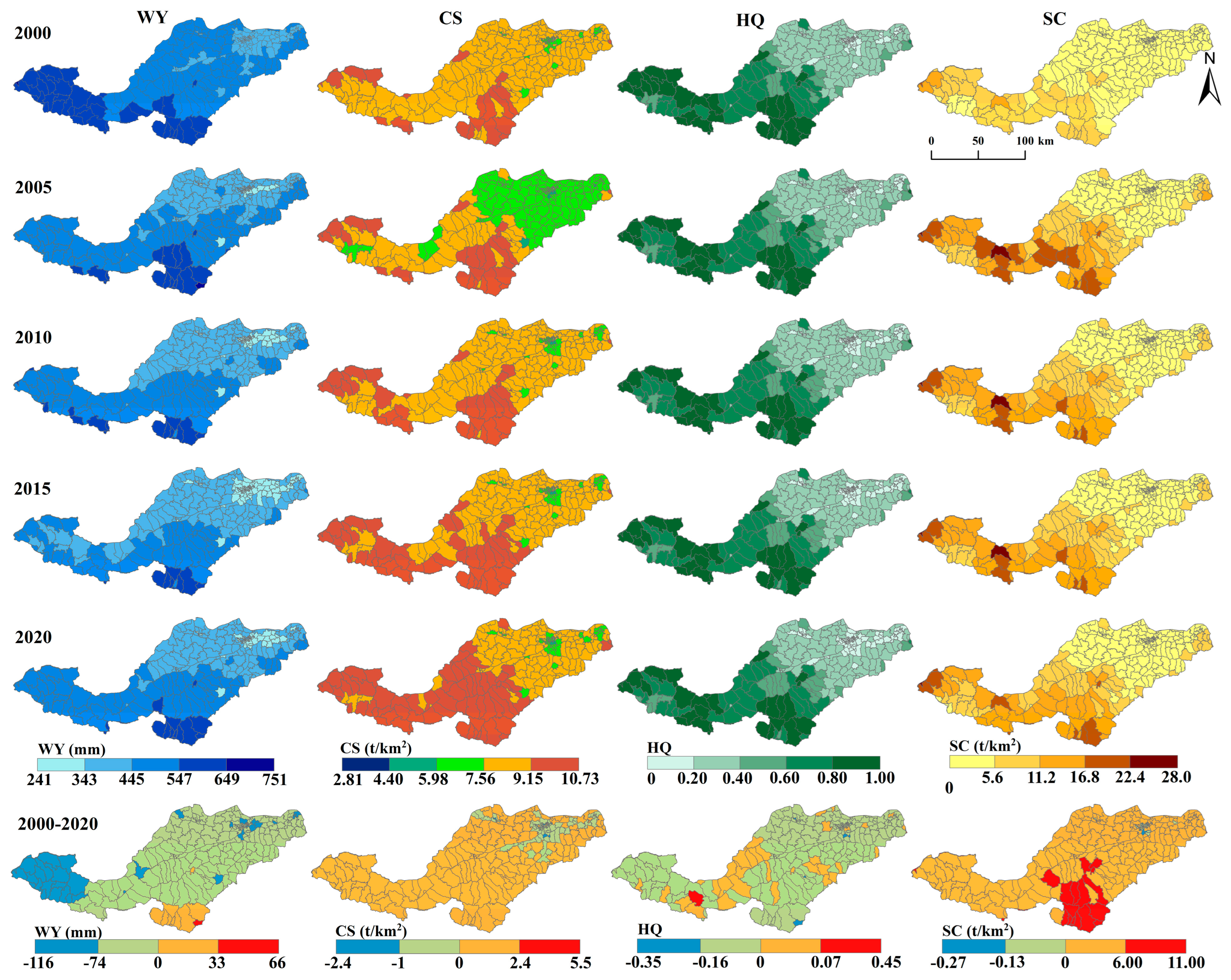
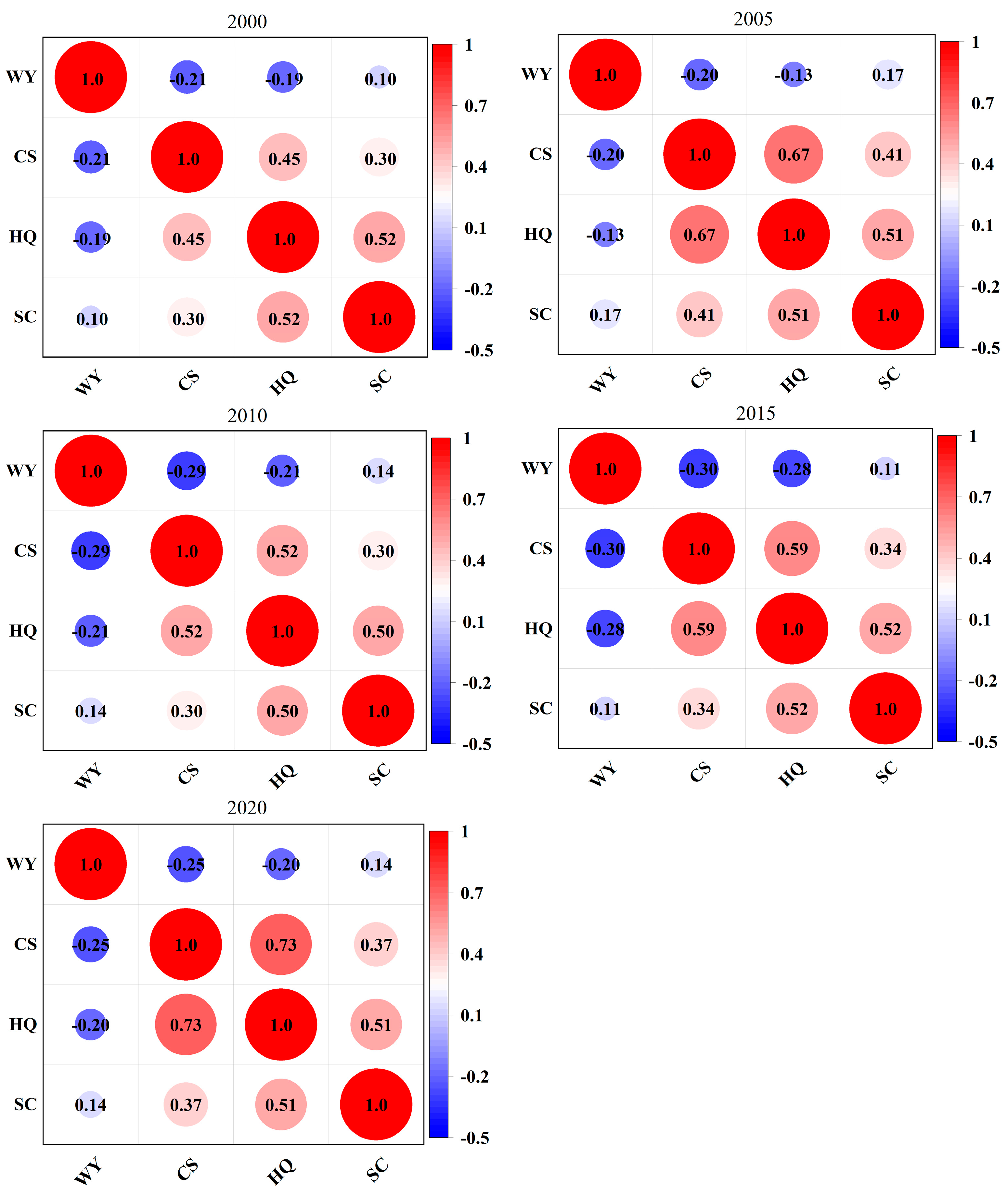

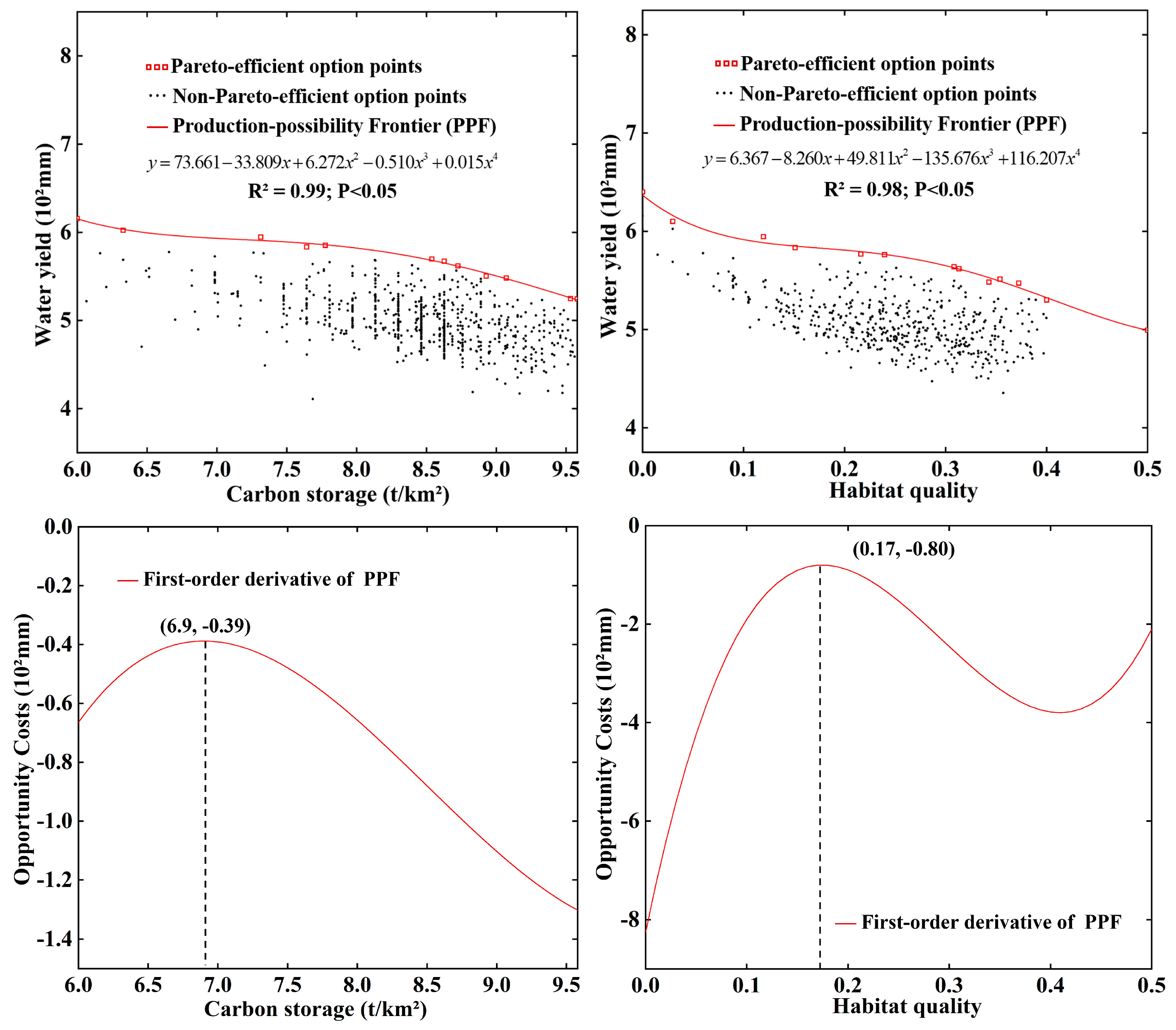
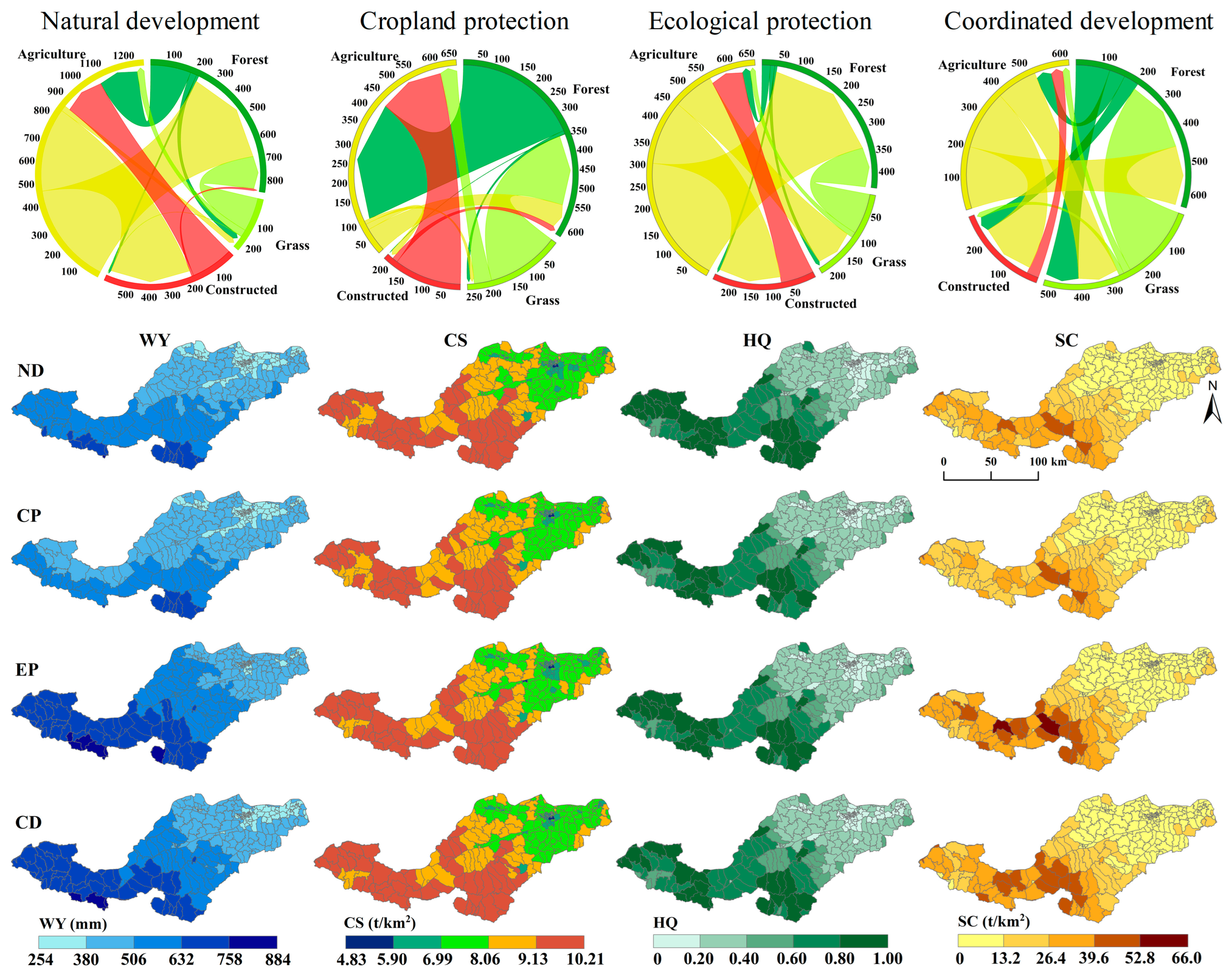
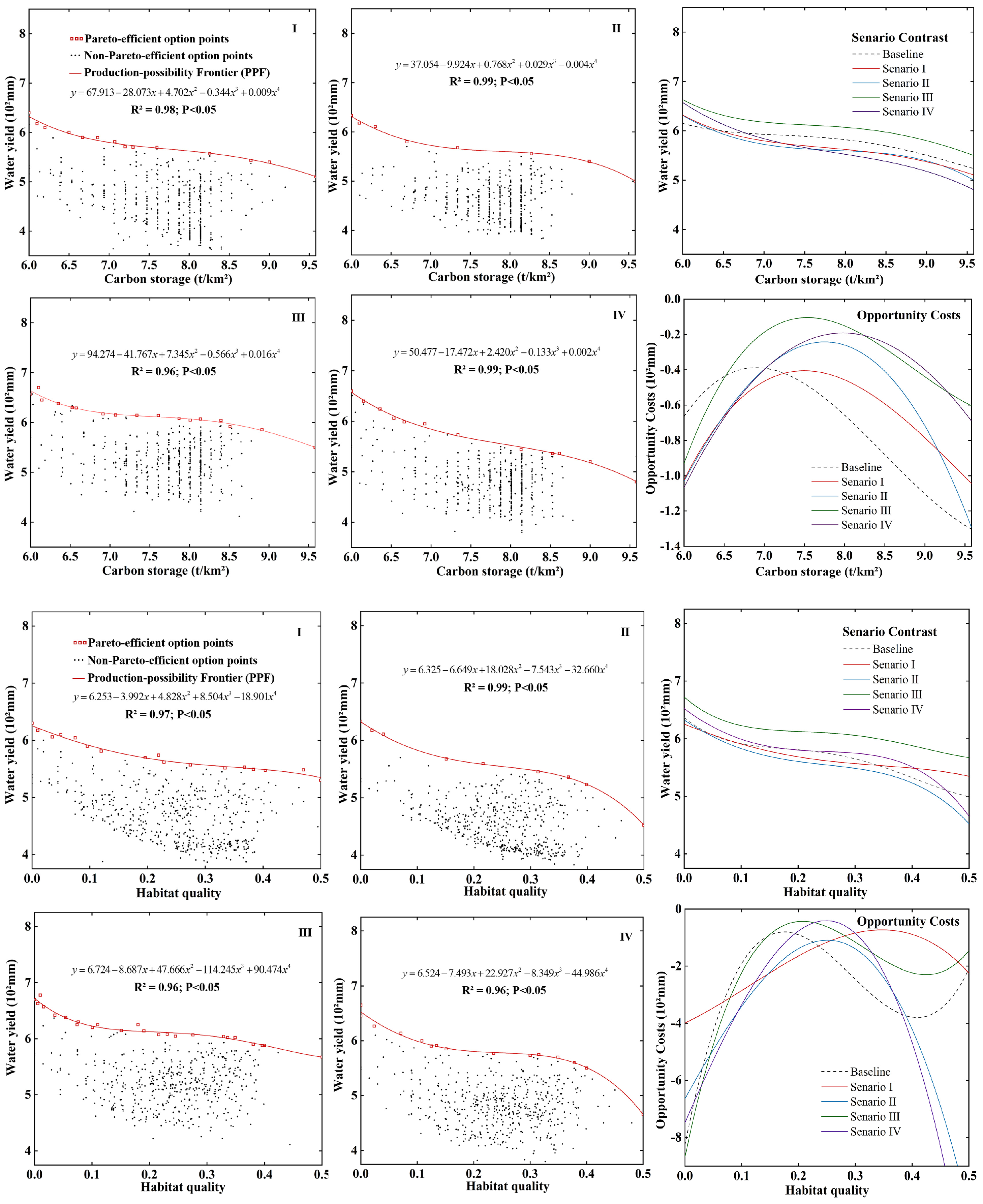
| Scenarios | Inflection Point | Synergy Potential | Trade-Off Intensity | Changes in Synergy Potential | Changes in Trade-Off Intensity |
|---|---|---|---|---|---|
| 2020 | (6.90, −0.388) | 17.464 | 0.69 | -- | -- |
| Scenario I | (7.50, −0.406) | 18.040 | 0.61 | 3.30% | −11.59% |
| Scenario II | (7.75, −0.242) | 19.013 | 0.58 | 8.87% | −15.94% |
| Scenario III | (7.54, −0.104) | 21.345 | 0.46 | 22.22% | −33.34% |
| Scenario IV | (7.98, −0.192) | 20.638 | 0.53 | 18.17% | −23.19% |
| Scenarios | Inflection Point | Synergy Potential | Trade-Off Intensity | Changes in Synergy Potential | Changes in Trade-Off Intensity |
|---|---|---|---|---|---|
| 2020 | (0.17, −0.804) | 2.833 | 0.62 | -- | -- |
| Scenario I | (0.35, −0.729) | 2.843 | 0.58 | 0.35% | −6.45% |
| Scenario II | (0.25, −1.091) | 2.761 | 0.49 | −2.51% | −20.97% |
| Scenario III | (0.21, −0.430) | 3.043 | 0.38 | 7.41% | −40.32% |
| Scenario IV | (0.25, −0.407) | 2.869 | 0.44 | 1.27% | −29.03% |
Disclaimer/Publisher’s Note: The statements, opinions and data contained in all publications are solely those of the individual author(s) and contributor(s) and not of MDPI and/or the editor(s). MDPI and/or the editor(s) disclaim responsibility for any injury to people or property resulting from any ideas, methods, instructions or products referred to in the content. |
© 2024 by the authors. Licensee MDPI, Basel, Switzerland. This article is an open access article distributed under the terms and conditions of the Creative Commons Attribution (CC BY) license (https://creativecommons.org/licenses/by/4.0/).
Share and Cite
Dai, Y.; Qiao, X.; Yang, Y.; Liu, L.; Chen, Y.; Zhang, J.; Zhao, T. Optimizing Land Use to Mitigate Ecosystem Service Trade-Offs Using Multi-Scenario Simulation in the Luo River Basin. Land 2024, 13, 1243. https://doi.org/10.3390/land13081243
Dai Y, Qiao X, Yang Y, Liu L, Chen Y, Zhang J, Zhao T. Optimizing Land Use to Mitigate Ecosystem Service Trade-Offs Using Multi-Scenario Simulation in the Luo River Basin. Land. 2024; 13(8):1243. https://doi.org/10.3390/land13081243
Chicago/Turabian StyleDai, Yulong, Xuning Qiao, Yongju Yang, Liang Liu, Yuru Chen, Jing Zhang, and Tongqian Zhao. 2024. "Optimizing Land Use to Mitigate Ecosystem Service Trade-Offs Using Multi-Scenario Simulation in the Luo River Basin" Land 13, no. 8: 1243. https://doi.org/10.3390/land13081243
APA StyleDai, Y., Qiao, X., Yang, Y., Liu, L., Chen, Y., Zhang, J., & Zhao, T. (2024). Optimizing Land Use to Mitigate Ecosystem Service Trade-Offs Using Multi-Scenario Simulation in the Luo River Basin. Land, 13(8), 1243. https://doi.org/10.3390/land13081243






